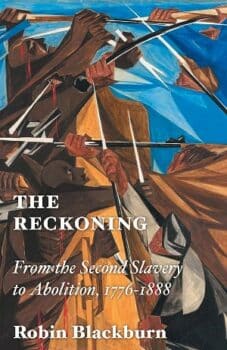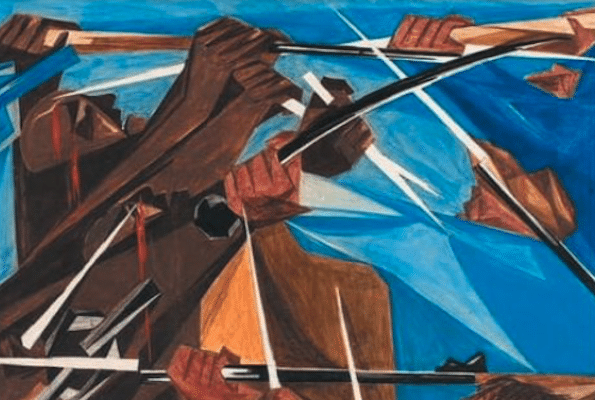In his fifth and final volume, The Reckoning: From the Second Slavery to Abolition, 1776-1888, in his series charting the history of slavery in the modern world, Robin Blackburn turns his attention to the Second Slavery, the plantation system in the United States, Cuba and Brazil growing cotton, sugar and coffee to meet the demands of Western Europe and the northern states of the USA.

Robin Blackburn, The Reckoning: From the Second Slavery to Abolition, 1776-1888 (Verso 2024), 544pp.
These were tied into the industries of both regions too, not least the cotton plants of Lancashire, and financed by their banks, who were happy to accept slaves as collateral for loans to planters. Thus slaves became not just working chattel but also property and investments.
With slaves being used as collateral, the slave owners could expand their plantations, or buy new opened lands elsewhere, by using them to take out mortgages or secure loans. Robin Blackburn argues: ‘A crucial feature of slave-owner capitalism was that the planter had collateral—his slaves—to finance improvements… A comparatively sophisticated U.S. financial system enabled investments to be made swiftly and effectively… Credit promoted crop specialisation within the South [of the USA], as well as opening up of new areas and a shift from tobacco and rice to cotton, sugar and wheat. Slave-holdings supplied collateral and the slaves themselves were—quite literally—a mobile asset playing their onerous part in the slave-holders capitalism’ (p.168).
Slavery and industrialisation
The slave system of production practised earlier in the Caribbean by Britain, France and Holland, was on a much smaller scale with little mechanisation. The Second Slavery centred on large-scale industrial cotton, sugar and coffee plantations which used machines; the best known was the cotton gin, but mechanisation also came to the Cuban and Brazilian sugar and coffee plantations. Far from making life easier for the slaves, it meant they were driven to work faster and for longer, in other words their exploitation increased.
Blackburn quotes figures showing that U.S. plantations boosted production fourfold between 1800 and 1860 (p.7). Railways were important too, helping to open up Cuba’s central plain and breaching the mountains of Brazil. However, the key to production was the slave and, to control him or her, the overseers, drivers and the armed bands, formed to catch runways, administered a system of vicious, organised violence.
Between 1810 and 1820, the number of slaves in the USA grew from one million to 1.5 million. Some 800,000 of them were driven, literally, from Virginia, Maryland and the Carolinas to the Gulf Coast and the Mississippi basin—the new heartlands of the slave-owning states (pp.50 and 52). In 1820, a third of Cuba’s population was made up of slaves, while by 1850 Brazil had 2.5 million slaves (p.60 and p.94).
The USA was the biggest buyer of Cuban sugar; exports of 49,000 tons went there in 1841. A further 25,900 tons went to Spain, 16,200 tons to Germany, 14,600 tons to France and 7000 tons to Britain. By then, Cuba produced a fifth of the world’s sugar, exporting 106,100,000 tons annually between 1832 and 1836 (pp.71-2).
A successful planter needed several hundred slaves and access to credit, which was available from the USA, Spain and Mexico. But Brazil and Spain relied on imports of enslaved Africans, whereas in the Southern States of the USA, the owners created an internal market via breeding. Problems would arrive for the Cuban and Brazilian owners when Britain and France stopped the trade completely and when they began to colonise the territories from whence the slaves were captured and shipped.
The USA was an independent state following its victory in the American Revolution, Cuba and Brazil were relatively autonomous; the latter became independent of Portugal in 1822, Cuba only broke with Spanish colonial rule in 1898, but fell under the vassalage of the USA.
In the ‘land of the free’, the Declaration of Independence declared ‘all men are created equal’ but that was for white men, usually property owners, not blacks and certainly not slaves. Leaders of the First American Revolution like George Washington and Thomas Jefferson were major slave owners, and they made sure that the new government guaranteed their right to own and exploit other human beings. However, because of that phrase, ‘all men are created equal’ in the Constitution, it became necessary to deny black people were human at all. That centred on creating and deepening racist ideology.
Slavery was key to the economic take-off of the USA in the early nineteenth century. Land was bought, (the Louisiana Purchase), which gave the USA the Mississippi Basin, conquered, (Texas from Mexico), and ethnically cleansed in the case of the indigenous population. In the case of the first two, they opened up new land for the slave owners, often on a bigger scale, which contributed importantly to the national wealth.
Resistance and abolition
Slavery was, of course, based on systematic racism which would pervade the history of the USA, and still does. That’s true of Brazil too. In Cuba, blacks have gained from the 1959 revolution in basic things like longevity of life. Before someone thinks I am some sanctimonious Brit, I am well aware Britain abolished the slave trade in 1807, but not slavery until 1833. Eric Williams, the great Trinidadian historian and nationalist leader, pointed out, tongue in cheek, how strange it was that Britain had constructed the largest and most profitable slave system in the Americas in order to have the satisfaction of suppressing it. The cotton industry was based on slave-grown cotton, and was key to Britain’s industrial revolution, the City of London supplied finance, while, even after the trade was abolished, British traders sold slave owners shackles and much else.
However, the Second Slavery existed under a shadow; the great slave revolt in Haiti which defeated both the French and the British to create an independent republic. Slaves rebelled time and again, despite the difficulties involved. The rebellion led by Nat Turner in Southampton County, Virginia, in August 1831 saw between 55 and 65 white people killed, making it the deadliest slave revolt for whites in U.S. history. In the repression which followed, the militia and white mobs killed as many as 120 enslaved people and free African Americans in retaliation. Fifty six slaves were executed, including Turner himself.
Then there was John Brown. He was white, but the seizure of Harpers Ferry in 1859 by his band of white and black militant abolitionists intended to open up a new route north for the Underground Railway which took slaves to freedom. Again the attempt was defeated and Brown hanged, but it radicalised the growing movement for abolition and raised fears in the South of a slave rebellion.
Freed Blacks like Frederick Douglass played a key role in that movement, as did former slaves in Cuba and Brazil. The prominence of black abolitionists such as Douglass challenged racism in the North and the more radical abolitionists followed their lead in demanding that the struggle against racial prejudice be an integral part of the struggle against slavery.
When Civil War erupted after the Confederacy seceded, the Northern states and Lincoln hesitated to enlist blacks, but Massachusetts, the centre of the abolitionist movement, did and the 54th Massachusetts Infantry Regiment, formed in early 1863 as the second African American military unit, distinguished themselves in the attempt to capture Fort Wagner in Charleston Harbor. Over half were killed, but their example opened the door to black enlistment with over 150,000 joining the Union army and navy.
Sheridan’s 1864 March to the Sea, from Atlanta to Savannah, which split the Confederacy in two, was joined by 350,000 slaves. By that stage, slaves were not just going north but effectively going on strike or on a ‘go slow’, undermining the plantation economy.
The Cuban revolution, which began in 1868 as a bid for independence, was based in the west of the island where there were fewer slaves but many black and mixed-race people who joined it in great numbers. In contrast, the plantation owners of the west rallied to Madrid and raised their own military units. The war lasted until 1878 when the rebels agreed a peace pact and laid down their arms. Former slaves who had fought for Spain were freed under its terms, but this created an untenable position. Full emancipation came just two years later.
Blackburn is excellent at charting all this and pointing to the rebel culture in the west of the island which Fidel Castro was able to exploit successfully later on. His account of the abolitionist movement is very good too, showing how it radicalised, with women taking a leading role and raising their own issues of equality and the suffrage.
American Civil War
His stress on both these things is important. The American Civil War was a revolution from above, like German and Italian unification, but there were also tremendous movements from below:
… The Civil War and Reconstruction did involve an extensive political mobilisation of class forces and only this sustained the central power in the making in the making of its revolutionary interventions (p.371).
Lincoln himself was reluctant to free the slaves, but in the course of the war, he was driven by the wider radicalisation in much of the North. Blackburn quotes Marx on Lincoln and Emancipation:
President Lincoln never ventures a step forward before the tide of circumstances and the call of general public opinion forbid further delay. But once “old Abe” has convinced himself that such a turning point has been reached, he surprises friend and foe alike by a sudden operation executed noiselessly as possible (p.315).
The North was now committed to Total War. Unfortunately, as Blackburn points out, the defeat of the Confederacy did not end white supremacism. Almost immediately after the Confederate surrender, the former slaveholding elite conspired and manoeuvred to maintain their wealth and their power.
Faced with the victorious North granting blacks the vote, they rigged elections, passed laws putting in place obstacles to being able to vote, such as literacy tests, and they used naked terror, courtesy of the Ku Klux Klan. An elaborate apartheid system was constructed, Jim Crow. While overturned by the mass civil-rights movement of the late 1950s and 1960s, they leave a legacy which still defines the USA.
I think what the book does is reject a mechanical view that the growth of industrial capitalism in the North automatically undermined slavery and that the Northern bourgeoisie were intent on eradicating it to ensure a system of ‘free labour’ existed across the USA. Where that’s true in part is over the issue of whether slavery could be further extended into the west and those lands that were cleared of the indigenous people. Northern capitalists wanted control of these, so, for instance, cattle could be bred for the slaughterhouses of Chicago.
Nevertheless, in general, the Northern bourgeoisie were ambivalent, and fearful abolition would de-stabilise things. There were important exceptions, as Blackburn notes. The abolitionist movement was the creation of a non-conformist middle class and it won the support of much of the working class—New York City was an exception. There was nothing guaranteeing abolition. It was forced on Lincoln as the only way to ensure victory.
The Reckoning is fine history. It covers a lot of ground and greatly expanded my knowledge of Cuba and Brazil. It brings to life the key characters involved and in explaining the economics of the Second Slavery never lets us forget the brutality under-pinning it. It kept me riveted throughout.
Note: I have used the term black rather than, say, African American, because prior to abolition they were not American citizens, and remained a long way short of full citizenry for many decades.

